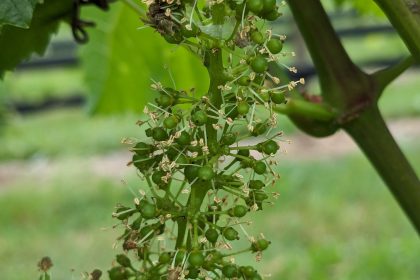Due to many rain events and relatively cold weather, it looks like we are somewhat back in truck in terms of the growth stages. When shoots are about 10-12 inches long (i.e., right now), downy mildew, powdery mildew, and black rot tend to show up. Then, at bloom time, flowers and young berries will be susceptible to these diseases, and young berries are susceptible until 4-6 weeks after bloom. In addition, Botrytis, ripe rot, and bitter rot can cause infection on flowers. Yes, it is a lots of diseases to think about. What you need to think about is which disease(s) have been the major issues at your vineyards. The disease history of your vineyards tends to repeat itself.
Downy and black rot management depend on weather condition. I have seen cases where downy or black rot developed prior to bloom under wet conditions, and this year would be such a case, if you could not keep up with the protection. If you have concerns on downy or black rot, think about the use of a DMI or QoI material for black rot, and Phosphite (= Phosphorous acid) or Metalaxyl (Ridomil) product for downy mildew. Revus, Zampro, and Ranman, can provide a very good protection against downy mildew. Based on the past few weeks of rain events and a trend of warm humid nights we observed, it would be a nice idea to think about downy mildew, since these humid nights can promote spore production of the downy mildew pathogen.
As for powdery mildew, I prefer to start powdery mildew management (i.e., the use of a DMI or other newer materials such as Quintec, Vivando, Luna, etc.) at pre-bloom application in our plots due to heavy powdery mildew pressure at our plots. It seems to reduce the cases of cluster infection for us. However, please note that in my vineyards, our trials tend not spray as often as many of you.
Development of Botrytis depends on what type of varieties you grow, as well as your canopy management strategies. White-fruited varieties with tight cluster architecture tend to be more prone to Botrytis. I.e., a red-fruited variety with loose clusters probably does not have many issues with Botrytis, especially if the canopy is well maintained. Bloom time is important for Botrytis management because this fungus can infect flower and flower debris, and come back later when berries are maturing.
Warm weather conditions help development of ripe rot and bitter rot. Both of them cause infection from bloom to harvest; however, you do not see actual rots until near harvest. It is very similar to Botrytis in this regard. Additional issue here is that both diseases can change the flavor of wine. If you have seen ripe rot or bitter rot, it would be a nice idea to protect flowers with mancozeb, captan, Ziram, or a QoI.
For Botrytis, ripe rot, and bitter rot, please keep in your mind that early season powdery mildew management can become important to prevent these diseases. These pathogens are very good at infecting through wounds (plus, the flower infection of Botrytis requires wounds to become rot); thus, scars, which will turn into opening of the skin, caused by powdery mildew infection on young berries can be the ideal targets for them.
Lastly, please keep in your mind about fungicide resistance issues. You can locate FRAC code on the fungicide label (or you can take a look at our Pest Management Guide). Even if two products are different in names or came from different companies, if they have the same FRAC code, they are basically the same in terms of fungicide resistance management. Please rotate the FRAC code. For newer materials such as DMI (or SI) or QoI or SDHI, my recommendation is not to repeat the application more than two times, and limit the use of it to no more than three times a season. Less number of application is better for fungicide resistance management.





